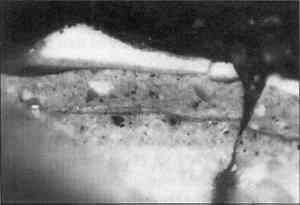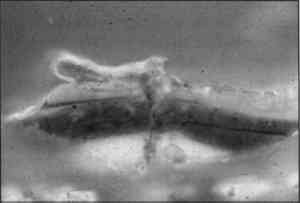INTERPRETING ARTIST'S INTENT IN THE TREATMENT OF JOHN CONSTABLE'S THE WHITE HORSE SKETCHMICHAEL SWICKLIK
3 EXAMINATIONInvestigation of the painting centered on whether it had been overpainted. The first step was a thorough examination of the paint surface through a binocular microscope. Compensating visually for the heavy layer of discolored varnish, some peculiar features in the upper paint layers were revealed. First, much of this paint had an odd, shriveled appearance. It was also clear that much of the cracquelure in the paint was not caused by the breaking of the paint, but by the shrinking of the upper layers of paint on a surface to which it was not well bound. The shriveling of the A more thorough binocular microscopic examination raised more doubt concerning the upper paint layers. In many areas the opaque, shriveled paint was deposited in cracks in the paint layers beneath it. Although this is usually a concrete indicator for differentiating overpaint from original painting, it was not such a conclusive observation in this case. The x-radiographs showed that there was a painting of Dedham Vale from the Coombs beneath the visible White Horse, but they only suggested that there was another earlier version of The White Horse beneath the obvious one. Therefore, it was difficult to decide if the paint lay in Dedham Vale cracks or in another painting of the White Horse image. In one particularly interesting area of foliage to the left, drying cracks in a layer clearly from The White Horse resulted from being painted directly on top of a thickly painted, bright green field in Dedham Vale that had not yet dried. On top of the cracked White Horse paint and oozing down into its cracks was a somewhat thick, transparent brown paint that covered a good part of the foreground landscape. This layer was clearly later than the layer that formed the initial painting of The Since the investigation of the surface with the binocular microscope indicated that the painting was probably heavily repainted in a hand other than Constable's, scientific analysis was required for confirmation. On the chance of finding more modern paints in these upper layers, pigment analysis in the form of dispersed samples examined with polarized light microscopy was the first method chosen. The results were confirmed with x-ray fluorescence analysis of the elemental compositions. Unfortunately, comparing the results of these tests against a history of Constable's pigment use found primarily earth pigments, lake pigments, white lead, black, and Prussian blue, all relatively common on Constable's palette (Cove 1991). Although mixtures in the trees contained a high propotion of emerald green, a pigment found less frequently in Constable's practice, the evidence clearly was not strong enough to establish that this paint was applied later. These results would seem to argue against the upper layers being overpaint. However, since it was known that any repainting would date prior to 1883, and because all the pigments in Constable's repertoire could have also been used later in the century, finding all common 19th-century pigments was not unexpected. Because simple pigment analysis did not prove helpful in this case, sampling by cross section was indicated. Cross sections from several different areas of the painting were taken, mounted, and analyzed through the microscope. Each sample shares an important feature with the two that are illustrated (fig. 6, p. 365). A heavy layer of varnish is visible between two paint layers, with thick applications of paint above the varnish and thin applications below it. In the thinner lower layers there are two distinct campaigns of painting separated by a thin layer of oil. Figure 6 is a cross section taken from the roof of the cottage in the central area of the foreground. It was hypothesized that the layers beneath the oil layer were from the lower painting, Dedham Vale from the Coombs, and that the similar layers just above the oil layer were from the original painting of The White Horse. One notable feature of both layers is their relative thinness and “neatness”; both
The later overpaint was so heavy as to almost completely obliterate what was beneath it. From the beginning, the study of the x-radiographs, particularly in the area of Willy Lott's cottage in the middleground, suggested that another version of The White Horse existed beneath the visible one. The evident form on the surface depicted only a single gable on the cottage, but Constable had painted this cottage many times from many different angles, always depicting it as it appeared in nature: as an L-shaped structure with two perpendicular wings and two gables in view. Invariably, the misunderstood representation of the house as it appeared was used by those who argued against the painting's authenticity and was itself another indication that the overpaint had been applied by a different painter. But in the x-radiograph it was clear that a properly rendered painting of the cottage existed beneath the one on the surface. Together with the evidence supplied by the cross sections that there were two distinct campaigns of similarly applied paint underneath the surface paint, it was virtually certain that there was some other version of The White Horse by Constable beneath the visible one. The treatment then required that the demonstrably later overpaint be removed to regain the original artist's intention. |

